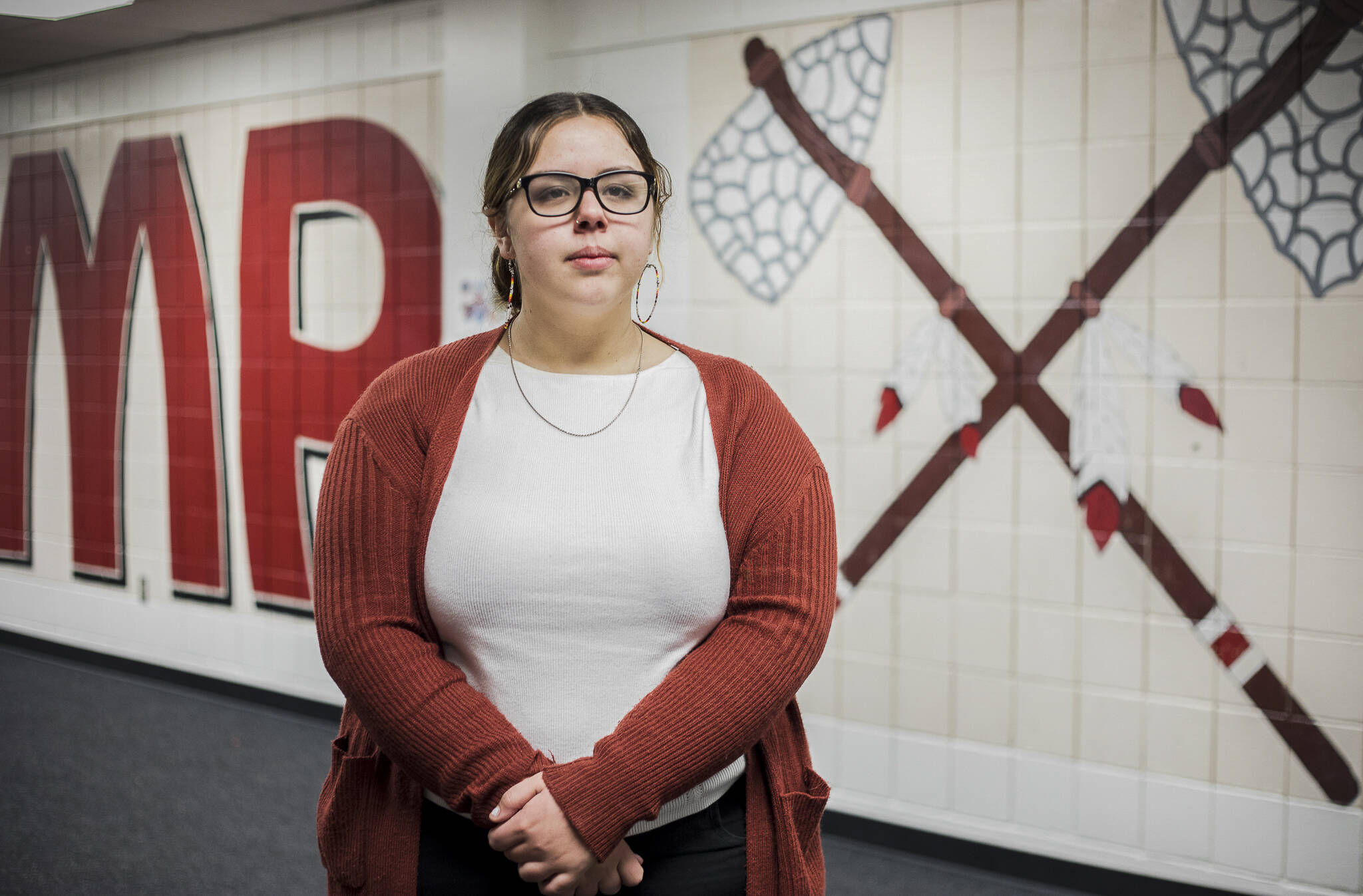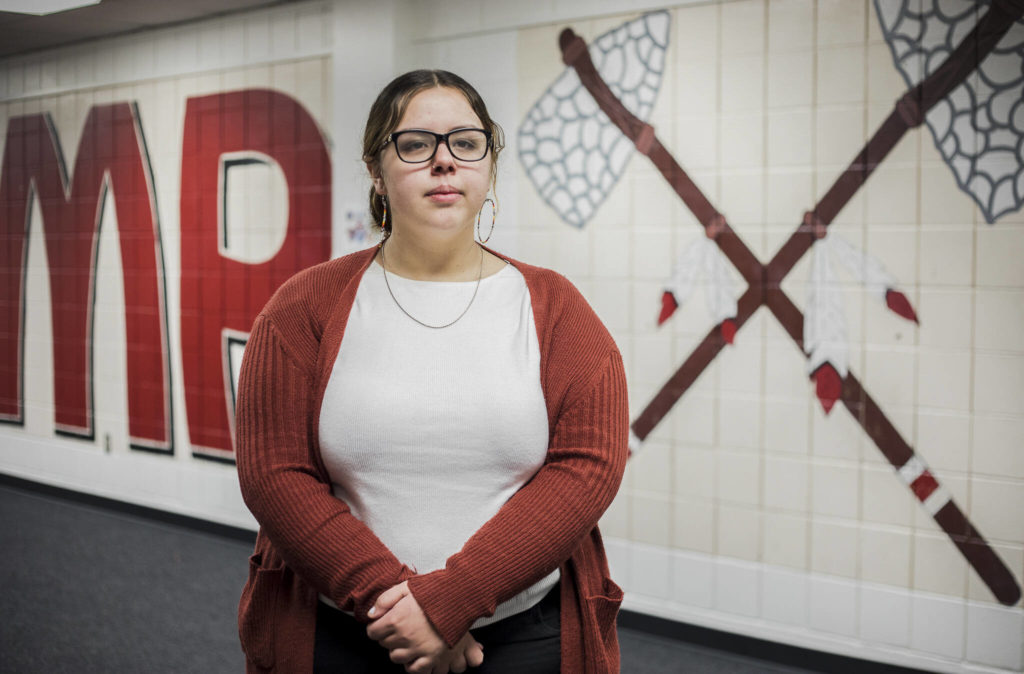MARYSVILLE — “It happened my first time when I was a freshman.”
Tony Hatch, a Marysville Pilchuck High School senior, has had racist slurs and war calls hurled her way while wrestling for the Tomahawks.
Hatch is a Tulalip tribal youth.
“It kind of gets me down because people don’t understand and want to be racist about it,” she said of the Tomahawks mascot. “It really sucks that they don’t even care to understand my culture or anything.”
Her dad, also named Tony Hatch, doesn’t want the mascot to be changed, she said. But not because he wants his daughter to endure racism.
“I think the racism was really, really bad when he was in high school,” she said. “I was just getting told stories about it last night.”
The Hatchs’ diverging opinions speak to a generational split within the tribal community. Some elders say they take pride in the Tomahawks mascot. But students in Marysville schools are speaking against it, explaining they are done being the targets of racist attacks.
Last week, the Tulalip Tribes Board of Directors sent a letter to the Marysville School District, which serves students on the reservation, to announce the Semiannual General Council voted in favor of maintaining the Tomahawks mascot.
Only tribal members 18 and older can take part in general council meetings, said Les Parks, an elder and former Tulalip Tribes Board of Directors council member.
After receiving the letter, Marysville School Board members discussed delaying a vote to change the mascot.
Theresa Sheldon, a Tulalip Tribal citizen and Native American political activist, said she’s “disappointed.”
“Why should the young people have to beg to you that their feelings matter?” she said. “Especially because they don’t even get to vote … they just have to do whatever we tell them and suffer.”
The semiannual meeting had low attendance. The vote was 92-83.
Typically about 1,200 tribal members show up to the Annual General Council meeting each spring, and a few hundred show up for the semiannual meeting in the fall, Parks said. He said the pandemic has affected attendance.
Many of those in support of keeping the mascot are elders. Decades ago they fought for the mascot as a means of being “seen.”
Parks said by the time he was a student in the 1970s, the mascot was already the Tomahawks, but he was always told “it came from the elders.”
In 1975, the tribes sent a letter to the Marysville School Board asking that the district maintain the name when Marysville and Pilchuck High Schools merged.
But times are changing, Chairwoman Teri Gobin told The Daily Herald last week.
Changing the mascot is not about removing Indigenous representation from the school, said Kaiser Moses, Tulalip Youth Council chairperson. “We’re asking for it to be positive and not come from a racist time.”
As of this fall, a Tulalip Tribes flag is flown on every Marysville school campus.
“There may be students and community members who speak to the experience of being a Tomahawk and having pride,” said Deyamonta Diaz, education advocate for the Tulalip Tribes. “I myself was a Tomahawk at one point and although I had very good experiences with sports, I still experienced some instances of racism.”
Diaz graduated from Marysville Pilchuck in 2011. Current students say racism is still a big problem in Marysville schools.
Earlier this year, Tulalip Youth Council members came before the tribes’ Board of Directors to ask for a change.
Many of them said they were tired of being tokenized through the mascot, and that it doesn’t “add to their value as a tribal student,” Diaz said. They shared personal experiences, and asked for further cultural education in the district.
After that meeting, the Tulalip Tribes asked the district to remove the mascot as required by state House Bill 1356. The law allows tribes to veto mascots they deem culturally insensitive if they belong to schools with boundaries on tribal reservation or trust lands.
Marysville Pilchuck and Totem Middle School went through parallel processes to pick new mascots this fall.
The process was democratic and took student and community input via surveys, focus groups and listening sessions along the way, Moses said.
During last week’s School Board meeting, members of Marysville Pilchuck High School’s mascot committee presented a final recommendation for the new mascot: the Mountaineers.
“The task of us as educators is to watch out for every student,” said Marysville Pilchuck High School Principal Brian Tinsley. “And that’s what kind of led us to come to the final recommendation.”
There’s empirical evidence suggesting the mascots are harmful to Native youth. Much of that was presented by the mascot committee during last Wednesday’s meeting.
According to the research presented, exposure to Native mascots increases non-Natives’ view that Natives are war-like, primitive, less honorable, more aggressive and less academically capable.
The use of Native American symbols as logos or mascots ultimately signals to non-Native students that such culturally abusive behavior is all right, Kelsi Rae Barron wrote in a 2016 Last Real Indians article.
Many Tulalip youth, like Hatch, say they have experienced racism because of the mascot.
Evelyn Vega-Simpson, a Tulalip Youth Council officer, graduated from Marysville Pilchuck in June.
“I know when I went to M.P. it was very hard,” she said. Native youth are “the ones dealing with it. We get the backlash. We get the harassment, the bullying, and all that kind of stuff. We’re the first line of defense.”
Sebastian Gomez, a Marysville Pilchuck junior and Tulalip Youth Council media coordinator, said the racism Tulalip and other Native youth experience in Marysville schools starts with being tokenized because of the mascot. But it goes beyond that.
“When we start drumming or singing they start mocking us,” he said. “… It just really hurts to see that because it’s my culture. … I want to show off my culture, but seeing that makes me a little scared. I don’t want to be harassed.”
Vega-Simpson said students can report racist incidents to the school’s Native American liaison, Matt Remle, and the Youth Council often discusses potential solutions in their meetings.
She said she feels many teachers have not been adequately trained in handling such situations, and there are not enough Native American teachers for Marysville Pilchuck students to look to for support.
This fall, the Marysville School District adopted a new educational equity policy, which includes a commitment to recruit and support a diverse workforce, use culturally responsive instructional methods and connect students to social-emotional and extra-curricular opportunities that strengthen inclusivity. Moses said the School Board and district staff invited Tulalip Youth Council members to give feedback on the draft policy along the way.
Eneille Nelson, executive director of equity and family engagement for the district, said equity advisory teams are working to develop a three-year action plan to put the policy in place. She said the committees aim to wrap up by the end of spring, but a separate plan for the remainder of this school year will likely be presented in January.
The advisory teams are made up of parents, students, staff and other community members.
Interim Marysville Superintendent Chris Pearson told The Daily Herald earlier this year that one of the main tenets of the district’s recovery plan is equity training for all staff. “These trainings are aimed to help teachers identify their own biases and assumptions, and to be proactive in creating classroom cultures where all students feel welcomed,” he said.
There’s still work to be done, Hatch said.
Vega-Simpson and Gomez said changing the mascot could be a good first step in making Marysville schools more welcoming for Native American students.
Gianna Frank, a student leader and member of the mascot steering committee, said it’s important to listen when a group of people says they feel uncomfortable.
School Board members said they need more time before they can vote on changing Marysville Pilchuck’s mascot. They were originally set to make a decision Wednesday night.
“I also feel like there’s three that voted yes, and one that voted no,” said School Board President Paul Galovin. “I feel like in order to hear the voice of the tribe, you got to hear the voice of the tribe. So I don’t know that this is done yet. We do need to have more discussion.”
While there are differences of opinion among some tribal citizens, the decision will only directly impact current and future students.
Sheldon said Native American mascots have led to the categorization, stereotyping and dehumanizing of Native people.
“There’s no middle ground for us. It’s Pocahontas or the chief. And so if you don’t fit in one of those two categories, then what are you?” Sheldon said. “Research shows all of this is connected to violence against women to Missing and Murdered Indigenous Women, to police killing brown people. It’s all of these things of how you dehumanize a whole group of people, works in the benefit of society. And that’s what we’re living in.”
“And we’re trying to say, ‘Hey, I’m a human and I deserve the same decency,’” she continued. “And it’s not about how you feel good when you’re cheering for a sports team. That should be the last of our concern.”
Isabella Breda: 425-339-3192; isabella.breda@heraldnet.com. Twitter: @BredaIsabella.
Talk to us
> Give us your news tips.
> Send us a letter to the editor.
> More Herald contact information.



























